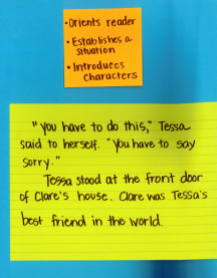I feel lucky to have, in addition to my community of SOL writers, a community of writers who nudge my creative work. Recently, we were away together for a weekend, and someone posed the question, “What are your goals?”
What are your goals?
I watched as a couple writers struggled with their answers. When we reflected on the weekend of writing, we all agreed that having, stating, and working toward clear goals increased our productivity and our overall sense of accomplishment. So how does this work translate to the work we do with students in classrooms? Here are a few ways to build goal-setting practices for writers of any age.
- Have students set goals for their independent writing time. At the end of your minilesson, students head back to their work spaces. You might consider establishing a practice where they write down their goal for their work of the day. Maybe they write their goal on a sticky note that stays on their desk. When that’s the case, it’s usually easier to confer with them because what they are working on (or supposedly working on) is right there in front of them. If they get good at setting goals and sticking with them, you can read their goal and double-check that you have the best teaching tool before you settle in for a conference, thereby increasing your efficiency and effectiveness.
While I love sticky-notes (I really, really do!), you might also consider setting up a daily goal section in student notebooks. I like this idea because it creates a record of what the work has been from a student’s perspective. This record could lead to some important reflective conversations about growth over time.
Some of the choices that we can teach students about goals involve:
- Skill-based goals such as:
- Writing an introduction with an engaging hook
- including a variety of evidence in a body paragraph
- making sure that there’s a balance of talking, thinking, and description in a narrative scene
- Production-based goals such as:
- productivity
- time on task
- number of lines, words or pages
2. Ask student to keep a running set of learning targets that they address and self-assess on a regular basis. I know this one sounds complicated, but it might be simpler than it sounds. I loved Lanny’s post about learning targets, and if you missed it, I recommend reading it now — or at least soon. As we teach our way through a unit, we should be teaching students specific skills that build on one another–how to think of an idea, how to plan, how to write a beginning, how to develop a scene… Our teaching points, which are mostly easily worded into learning targets by making them into “I can” statements, vary depending on genre and level. However, they should be clear to students. And here’s how they could be clearer. What if students keep their own learning targets page in their notebooks. Not a professionally made checklist. Not a teacher-created list either. Instead their own list that they are responsible for maintaining, addressing, and self-assessing. The lesson that would go along with it would be similar to a lesson about writing down daily goals. We could say something along the lines of:
“As I teach, it’s your job to write down what I’m teaching in your notebook in a way that makes sense to you. It might be exactly how I present it, and it might be that you change the phrase a bit so that it’s clear to you. As we work our way through the unit, you should end up with a list of “I can” statements that you can review daily, thinking about whether you can already, you almost can, or you’re working on it. That way you’re constantly thinking about your own learning process, which is what serious learners do.”
3. Develop and use progressions of skills that you share often with students. Progressions are admittedly a bit of a pain to write, but if you commit to doing a few, collaborating with colleagues to share some, or even enlisting some students to help in their creation, you’ll end up with a collection sooner than you’d think. To make one, think about the skill you want to address, and then create three lanes of that skill. I usually use the Common Core State Standards to give me three levels of the same concept. For example, here is a progression of the beginning of a realistic fiction story.
With this progression in hand, I can ask students which level they want to reach for. I can even leave them with the progression or have them copy the bullets on the orange sticky note, depending on what they need as a learner. Once they’ve set their intention, students have clarity as to what they are working on and what it should look like if they can say they’ve been successful.
While John Hattie who wrote Visible Learning has changed the order of his highest-impact teaching strategies, clarity and self-reported grades have consistently been top influencers of student learning. Having and stating goals takes courage, but this practice also leads to higher levels of learning and achievement– just ask my writing group!





The visible is powerful. Thanks for the reminder. I plan on getting back to this and implementing it in my room.
LikeLike
I will be referring to this post often. Thank you for the ideas!
LikeLike
You have a rather ambitious and elaborate framework for helping students promote their own objectives. Moreover, this is differentiated, and students assess themselves. No doubt, you have worked for years to get to this point. Compliments.
LikeLike
This seems to be an area of struggle in my collaborative group, helping student set self directed goals. Perhaps this a jumping off place. I will reread Lanny’s post.
LikeLiked by 1 person